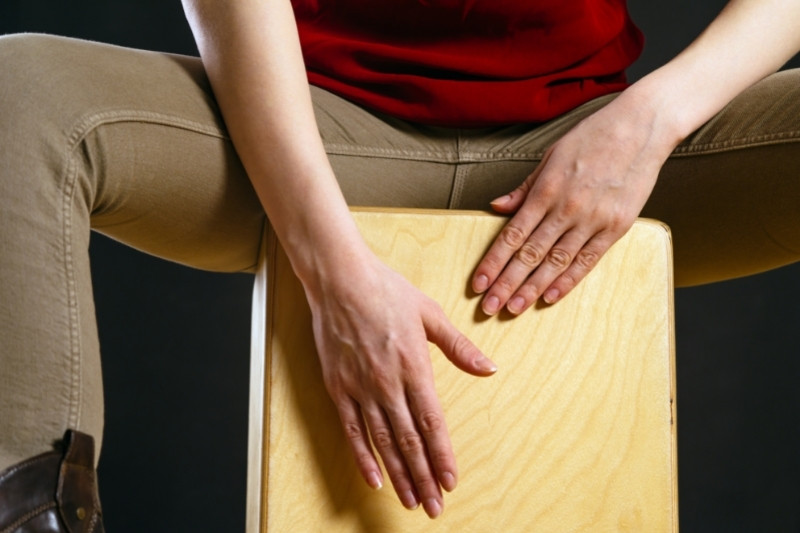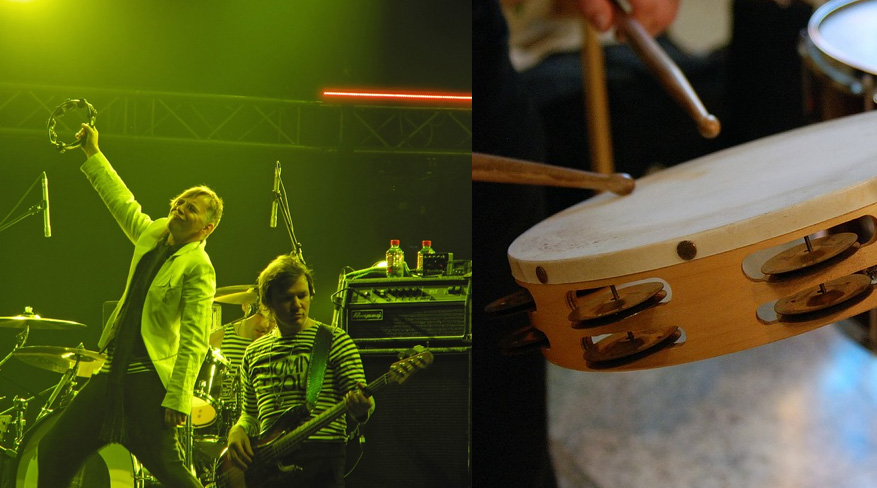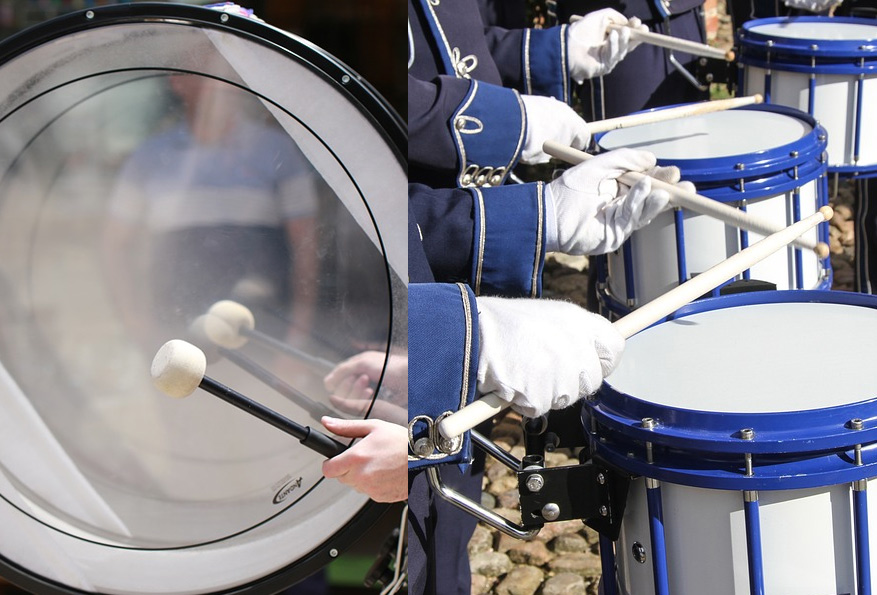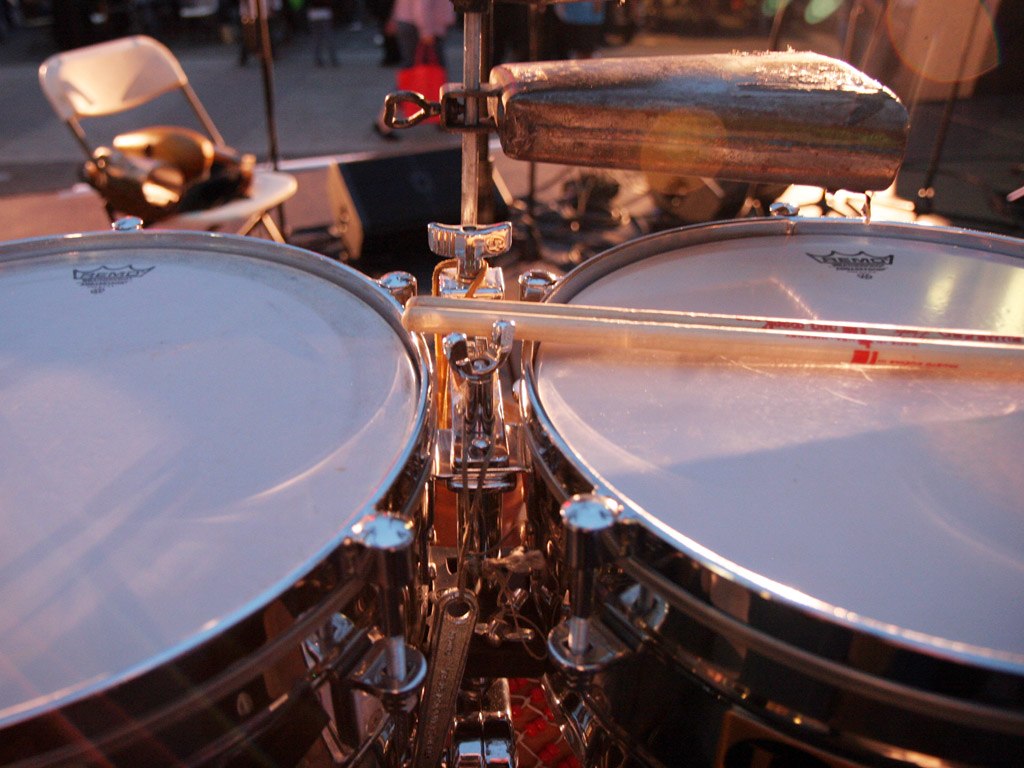How to Play the Cajon (Getting Started)
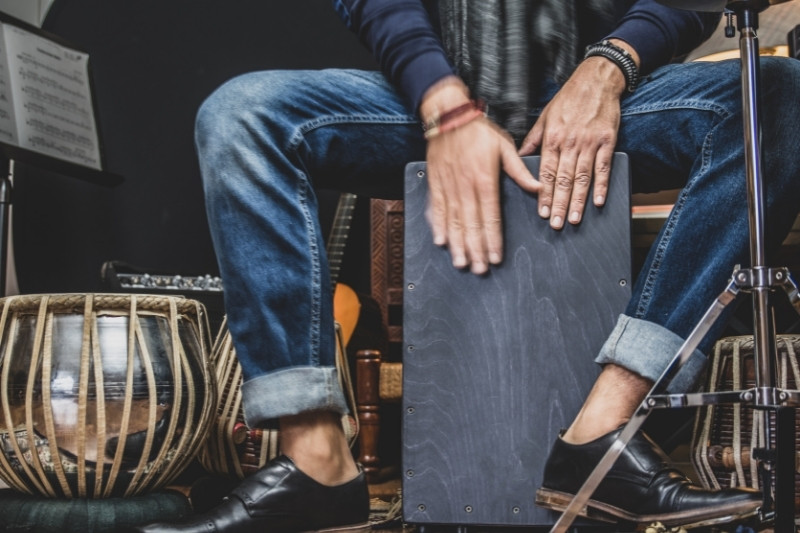
The Cajon is one of the most popular percussion instruments today. Originated from Peru, the Cajon drum is widely used in many different music genres, from flamenco to mainstream pop music.
These lightweight Cajon boxes are used as substitutes for drums, as it is portable and easy-to-play percussion instrument.
The Cajon is a box drum played mainly with hands or accessories like sticks or brushes. They are often made from thick woods covered with thin plywood. Originally they were wooden boxes, but the classical guitar virtuoso Paco De Lucia added stretched two to four guitar strings in the Cajon to have a better sound with bass and snare drum sounds separated.
The Cajon is an easy percussion instrument to learn but hard to master. To start, you have to learn about the different parts of the Cajon, how to sit on and position it, how to hit to have different sounds and how to create basic rhythmic patterns to build on top. As with most musical instruments, being patient and building a good technique are essential to playing the Cajon.
If you want to see how it’s played in action, check out the below video:
Contents
Learning The Basics – The Parts of the Cajon
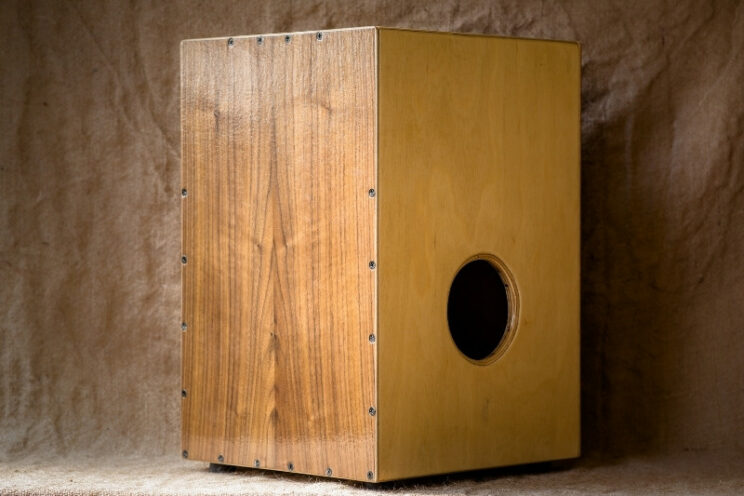
cajons are wooden box drums that you sit on top while playing. They can be made of different hardwoods, which resonate when hit to produce various tones.
Cajons are versatile percussion instruments that respond differently to hits with different intensities and areas of the instrument like the top, middle, or sides.
In order to build a proper technique and learn how to play Cajon, first, you have to learn about the parts and understand the construction of the instrument. A Cajon has four important parts; the face (the tapa), snares, top and soundhole.
The face, or so-called the tapa, is the thinnest part of the Cajon. As it is the main playing surface, this is where you will strike mainly.
The top is where you sit while playing the Cajon. It has to be well constructed to carry the weight of the player.
The sound hole is found on the back of the Cajon and is where the sound gets out. It is also the gateway to the inside of your Cajon to tune the strings if yours have any.
The strings, which are also called the strings, are found in the inside part of Cajons and act as a snare to create the buzz sound that elevates the versatility of the Cajon. Not every Cajon has these strings, but most of the modern ones do.
Position & Posture – How Do You Sit on a Cajon?
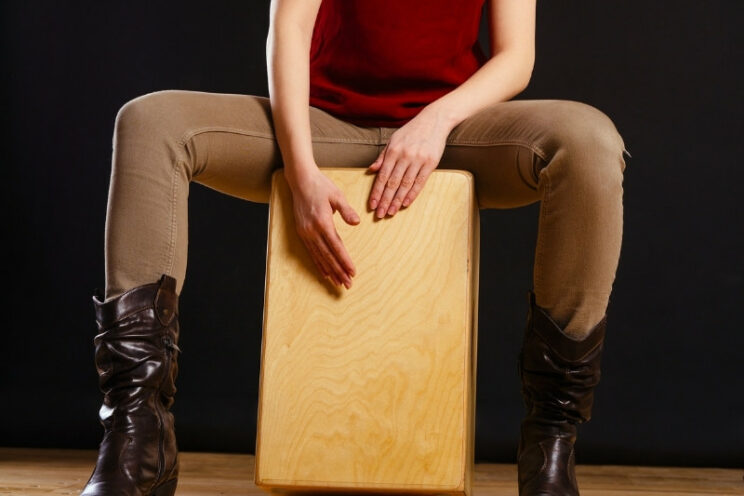
The first thing to learn when playing Cajon is how to sit on it. Your playing position and posture significantly affect your technique as well as your health.
Beginners commonly tend to stoop forward when playing Cajon to reach the tapa and have better control. This position not only makes it harder to play but can cause chronic back problems in the long term.
The position of your back, shoulders, and hips is crucial for a proper technique when playing Cajon. Before everything, you should have a proper position and good posture on the instrument as it will be harder to change them if you get used to playing like that.
To build up a proper technique of sitting position and body posture when playing Cajon, you have to put your attention to these factors:
1. Straight Back
Your back should be straight most of the time when playing the Cajon. You may lean forward to reach the sides or the bottom part of the tapa in some moments but mainly keep your back straight.
This is crucial when playing Cajon, as stooping forward is the biggest rookie mistake. It will hinder your technique, as you have less power that way and cause chronic back problems. It will also give you pain after extended hours of playing, which will lead you to play badly or stop playing.
2. Sitting On The Back Of 2/3 Of The Top
You should sit on the back two-thirds of the Cajon and lean a bit forward without slouching. You should not sit too far forward or too far back. If you sit too forward, you won’t be able to play easily, as most of the Cajon strikes are focused on the upper parts of the tapa. If you sit too far back, the Cajon will be unstable, and you will lose your balance.
3. Feet On The Floor
When playing Cajon, your feet should always be touching the floor. Your knees should be slightly bent and spread to the sides so you can easily reach the tapa with your hands. You should aim for an angle between 90 degrees to 120 degrees in the groin area. You can adjust yourself between these angles to comfortably reach the sides and the tapa.
4. Hips And Face On A Straight Line
Your hips and face should be standing in a straight line. You do not have to lean too forward or back as you will be mostly hitting around 5 inches from the top of the tapa.
5. Relaxed Body
Most important of all, you should have a relaxed body. Trying to be attentive to all of your body parts mainly results in tension in bodies with the beginners. But, tension and stiffness, especially in your arms and back, will negatively impact your playing, slowing your movements, reducing your accuracy and timing.
You do not need to strike hard to create nice sounds with the Cajon. So, try to have a relaxed body and play balanced with softer touches.
In short, you should play the Cajon with a relaxed body, straight back without leaning too forward or back, and steady and strong feet on the floor.
How to hit the Cajon? – Playing Techniques
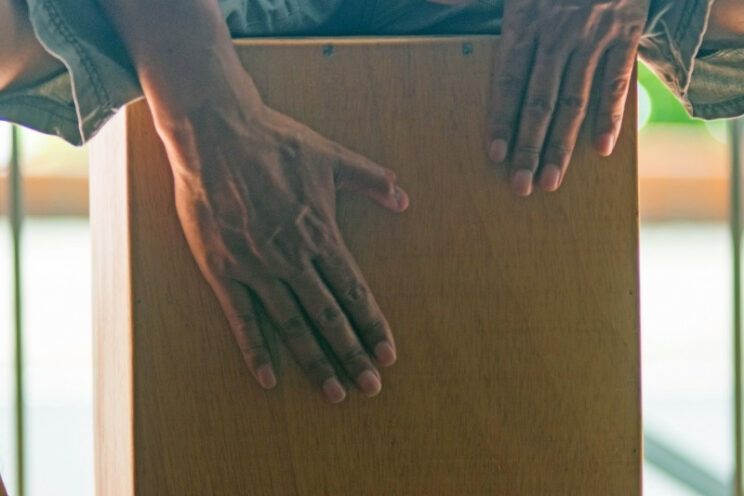
The basic strikes a beginner should learn are the bass stroke, slap stroke, high stroke, muted stroke, and ghost notes.
The Cajon has many different striking techniques borrowed from different percussion instruments and used in different genres, from flamenco music to modern rock.
Learning different striking techniques will enrich your repertoire with different tones you can use. Try to master as many of them with the most proper technique to master the instrument. Try to play each striking technique with your right hand and left hand separately until you get the right sound.
1. Bass Stroke
Bass beats are the main elements of rhythms. That is why it is crucial to have a bass stroke technique on the Cajon. When compared to a drum kit, the bass stroke is your kick providing deep bass tones. The most common method to create bass tones with a Cajon is to use the entire palm of your hand and strike the top part of the tapa.
The significant part of your hand below the lower palm and your wrist should touch the tapa. It is okay if your lower palm and wrist do not touch. So, you will be aiming to strike around 5-6 inches below the top of the tapa.
After the hit, try to pull your hand quickly off the tapa to let the instrument resonate. The motion should be like a ball bouncing off a surface. The strike movement should be from the wrist and the arm.
You do not have to hit it strong or hard; a moderate amount of strength will get the job done. You can experiment with striking your fingers closed and open. Both will create different bass tones.
2. High Stroke
High stroke produces the contrast sound to the bass stroke. It is used for more bright and high-sounding strikes like the snare drum sound, and the technique is pretty straightforward. You hit the most upper part of the tapa with three fingers. Only the below-knuckle part should touch the tapa and bounce off immediately.
Try to hit with fingers straight and relax the muscles after the hit. This way, it will be easier for them to bounce, and the strike will sound better. Also, relaxing the muscles will help you use your stamina more effectively.
You can experiment with hitting two fingers and different angles to create various types of high strokes. There is no exact recipe for high strokes as the technique may vary from individual to individual and instrument to instrument.
3. Slap Stroke
Slap stroke is a variation of high stroke and is an important percussion technique. It produces a dominant sounding bright slap sound like an accented snare drum hit. The technique is slightly harder than the regular high stroke, as here, the palm is also used with the fingers.
When using the slap stroke technique, you contact the tapa with the middle of your palm and catapult your fingers afterward to produce the slap sound. Your fingers can be together or apart, but they should be relaxed instead of tense. This time you don’t bounce your fingers immediately off the tapa but let them stay there for a moment.
Slap stroke is not an easy technique to master and takes time and patience. You can practice it anytime on any kind of surface by touching the surface with your palm before driving your relaxed fingers forward and slapping the surface. You should practice it with low volumes and less power as the best sound can be achieved this way.
4. Muted Stroke
Muted strokes are variations of high strokes and bass strokes without letting the Cajon resonate. To achieve that, instead of bouncing your hand or fingers off the tapa, you leave them there, muting the Cajon. Do not hit or press the Cajon hard; just leave your hand and fingers on the surface after the strike.
5. Ghost Notes
Ghost notes are crucial parts of any rhythm instrument as they are the fills of silence. Any rhythmic pattern beat or groove has spaces between the hits, and these spaces should be filled with light touches to keep the flow going. This is where the ghost notes or the touch strokes come into play.
Ghost notes are light touches on the instrument and are barely heard. They are there to fill the spaces between the accents and give thickness to the groove. The technique to play them vary between cajon players as some use light finger touches, and others use entire hands for the technique.
Either way, ghost notes are very soft, barely hearable touches between the accents. I find it easier to use the fingers on the most upper part of the tapa. It is like playing high strokes but with less power instead of strikes with barely hearable touches.
The most important thing with the ghost notes is the consistency. The power and the resulting sound should be on the same level with good contrast to accented beats. This way, you create the dynamics, which is one of the most important parts of playing Cajon.
Timing and Basic Rhythm Patterns
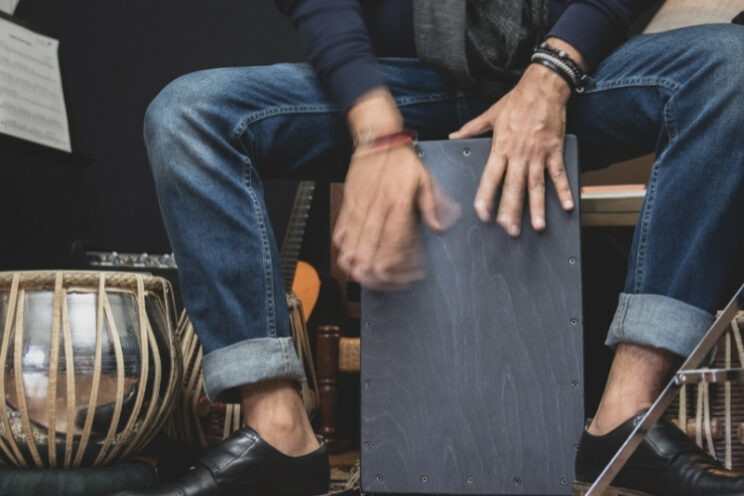
As with any percussion instrument, the fundamental part of proper playing is the timing and rhythmic sensation.
As a percussionist, you dictate the tempo and rhythm to other instruments; that is why you have to be spotless with your timing and rhythm sensation. It may not be that clear while you play alone, but it becomes crucial when you start playing with your friends or other instruments.
That is why the metronome should always be your best friend when practicing playing any percussion instrument, including the Cajon. Without proper timing, any groove you play, even with advanced techniques, won’t sound good.
I recommend you to play with the 8th note subdivision before going to quarter note-metronome clicks to build up your internal clock and develop your sense of timing.
You can check this exercise to work on your timing and practice your internal clock. It is a great exercise that makes you practice the bass strokes, the high strokes, and the ghost notes with different metronome speeds.
Another exercise I recommend you to regularly practice is the basic strokes exercises. Set your metronome to 70 BPM and play 2 bass strokes, 2 ghost notes, 2 slaps, and 2 high strokes. You can raise the difficulty and set the metronome to 80 BPM when you feel comfortable and repeat the strikes. You can go on until 120 BPM to master the striking techniques.
After getting the striking techniques and basic timing right, you can go on to playing some basic rhythm patterns. The following video has 5 great beginner-level Cajon beats that are not only fun to play but also force you to progress with your striking techniques and timing.
Always watch yourself while playing and try to examine your mistakes and habits that are letting you down. That is why recording yourself is very important, as it allows you to observe your mistakes. If you do not have recording gear, you can use your phone to make a video of yourself playing.
Never fear making mistakes, as that is how we learn to play any instrument. Just keep trying and try to be better than yesterday, building up your technique and playing with patience. There are many youtube channels and videos on Cajon lessons to help you on your journey to be a whole Cajon player.
Summary
The Cajon is one of the most versatile and fun to play percussion instruments, thanks to its simplicity and portability. The Cajon is an ideal choice of percussion to accompany any instrument and play any genre.
Although it is an easy instrument to learn and start playing, it is a hard instrument to master and play professionally. There are many different techniques to explore and add to your repertoire.
First, you should adjust your posture and position on the instrument before playing. After that, start playing and practicing the basic striking techniques to get the hang of the instrument’s sound. And finally, start playing some basic grooves and rhythmic patterns to develop your timing and inner clock to be able to play with other instruments and your friends.

